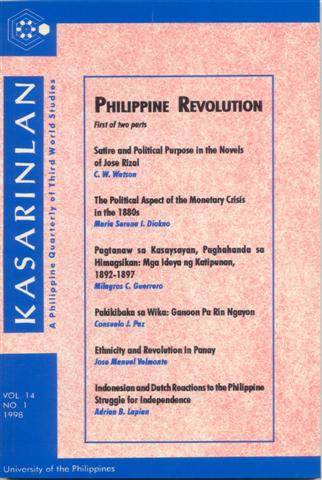Pagtanaw sa Kasaysayan, Paghahanda sa Himagsikan: Mga Ideya ng Katipunan, 1892-1897
Abstract
The writings of the leaders of the Katipunan, Andres Bonifacio and Emilio Jacinto, fueled a widely accepted belief among scholars and historians that the revolutionary movementís ideas were not only unsophisticated repetitions based on the works of the propagandists, the most compelling of which are the novels of Jose Rizal, but were also said to be narrow in terms of scope and intent. It has been common practice to denigrate the contributions of Bonifacio and Jacinto due to their nonilustrado backgrounds. Many historians have perpetuated the misconception that the Katipunan’s hopes and aspirations for the country were limited. They were regionalistic because of their reference to the motherland as the “land of theTagalogs.” But a closer examination of the written works of Bonifacio and Jacinto reveals a simple but exhaustive political discourse that would provide guidance for an unpoliticized people wanting to be free of their colonial masters. While the Spanish government dismissed the revolt as an isolated Tagalog uprising, the Katipunan was aiming for the integration of all enthno-linguistic groups. In Kartilya, Jacinto referred to the Tagalogs as those raised in the archipelago, embracing all inhabitants regardless of regional affiliation. Carlos V. Ronquillo, personal secretary of revolutionary president Emilio Aguinaldo, likewise spoke of this in his memoirs, stating that Tagalog actually meant taga-ilog or those who live by the river.That the Katipunan was an offshoot of the ilustrado-led propaganda movement, which was at the time pressing for mere reforms and not independence from Spain, was another lie perpetuated by many historians. By addressing their countrymen as Filipinos instead of Tagalogs, Rizal and Graciano Lopez Jaena appeared to have had the intention of creating a different national identity when in fact Filipino was a Spanish term for Spaniards born in the Philippines. This is not surprising considering that the ilustrados demanded mere reforms from Mother Spain that would benefit their kind and not independence that would benefit all.
Bonifacio also realized the power of a separate history for the Tagalog people though he suffers in Rizalís long shadow. The reader need not bother with Rizal’s version of Antonio de Morgaís Sucesos de las Islas if he has breathed in Bonifacio’s Katapusang Hibik ng Pilipinas, the latter a 14-stanza chronicle of life under Spain. Rizal’s Noli Me Tangere and the El Filibusterismo, though undisputed classics, were read and understood only by the few who managed to secure smuggled copies. The Solidaridad, a major propaganda vehicle, was of brief and limited circulation. By using the more commonly used Tagalog, Bonifacio brought the Katipunanís vision closer to the heart of the people. Ignored for a hundred years, the “unsophisticated” legacy of Bonifacio, Jacinto and the Katipunan remains the most enlightened, unsurpassed by the most brilliant minds of the propaganda movement.
Published
2009-07-24
How to Cite
GUERRERO, Milagros.
Pagtanaw sa Kasaysayan, Paghahanda sa Himagsikan: Mga Ideya ng Katipunan, 1892-1897.
Kasarinlan: Philippine Journal of Third World Studies, [S.l.], v. 14, n. 1, july 2009.
ISSN 2012-080X.
Available at: <https://journals.upd.edu.ph/index.php/kasarinlan/article/view/1407>. Date accessed: 20 aug. 2025.
Section
Features
By submitting a manuscript, the authors agree that the exclusive rights to reproduce and distribute the article have been given to the Third World Studies Center.



